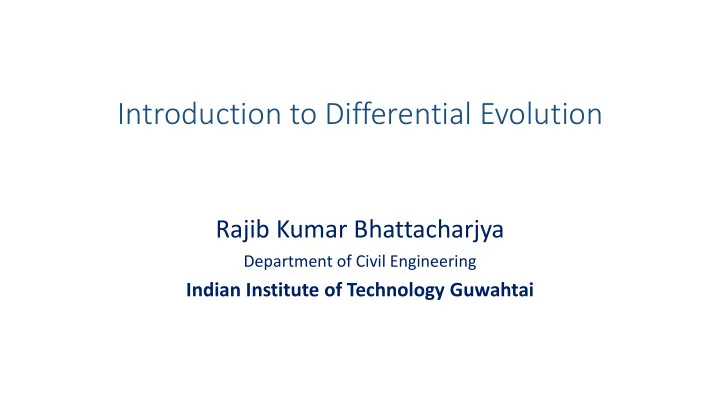

Introduction to Differential Evolution Rajib Kumar Bhattacharjya Department of Civil Engineering Indian Institute of Technology Guwahtai
Differential Evolution It is a stochastic, population-based optimization algorithm for solving nonlinear optimization problem The algorithm was introduced by Storn and Price in 1996 Consider an optimization problem Minimize 𝑔 𝑌 Where 𝑌 = 𝑦 1 , 𝑦 2 , 𝑦 3 , … , 𝑦 𝐸 , 𝐸 is the number of variables
Evolutionary algorithms Initialize Mutation Recombination Selection population Termination Next Generation Criteria This is a population based algorithm Yes No Consider a population size of 𝑂 Optimal Solution The population matrix can be shown as = 𝑦 𝑜,1 , 𝑦 𝑜,2 , 𝑦 𝑜,3 , … , 𝑦 𝑜,𝐸 𝑦 𝑜,𝑗 Where, is the Generation and 𝑜 = 1,2,3, … 𝑂
Initial population Initial population is generated randomly between upper lower and upper bound 𝑀 + 𝑠𝑏𝑜𝑒 𝑉 − 𝑦 𝑜,𝑗 𝑀 𝑜 = 1,2,3, … 𝑂 𝑦 𝑜,𝑗 = 𝑦 𝑜,𝑗 ∗ 𝑦 𝑜,𝑗 𝑗 = 1,2,3, … 𝐸 and 𝑀 is the lower bound of the variable 𝑦 𝑗 Where 𝑦 𝑗 𝑉 is the upper bound of the variable 𝑦 𝑗 Where 𝑦 𝑗
Mutation , 𝑦 𝑠2𝑜 From each parameter vector, select three other vectors 𝑦 𝑠1𝑜 and 𝑦 𝑠3𝑜 randomly. Add the weighted difference of two of the vectors to the third +1 = 𝑦 𝑠1𝑜 𝑤 𝑜 + 𝐺 𝑦 𝑠2𝑜 − 𝑦 𝑠3𝑜 +1 is called donor vector 𝑤 𝑜 𝐺 is generally taken between 0 and 1
Recombination +1 is developed from the target vector, 𝑦 𝑜,𝑗 , and the donor vector, A trial vector 𝑣 𝑜,𝑗 +1 𝑤 𝑜,𝑗 +1 𝑗 = 1,2,3, … 𝐸 and 𝑤 𝑜,𝑗 𝑗𝑔 𝑠𝑏𝑜𝑒() ≤ 𝐷 𝑞 𝑝𝑠 𝑗 = 𝐽 𝑠𝑏𝑜𝑒 +1 = 𝑣 𝑜,𝑗 𝑦 𝑜,𝑗 𝑗𝑔 𝑠𝑏𝑜𝑒() > 𝐷 𝑞 𝑏𝑜𝑒 𝑗 ≠ 𝐽 𝑠𝑏𝑜𝑒 𝑜 = 1,2,3, … 𝑂 𝐽 𝑠𝑏𝑜𝑒 is a integer random number between [1,D] 𝐷 𝑞 is the recombination probability
Selection is compared with the trial vector 𝑣 𝑜,𝑗 +1 and the one with the The target vector 𝑦 𝑜,𝑗 lowest function value is selected for the next generation +1 < 𝑔 𝑦 𝑜 +1 +1 = 𝑣 𝑜,𝑗 𝑗𝑔 𝑔 𝑣 𝑜 𝑦 𝑜 𝑦 𝑜 𝑃𝑢ℎ𝑓𝑠𝑥𝑗𝑡𝑓 𝑜 = 1,2,3, … 𝑂
Recommend
More recommend